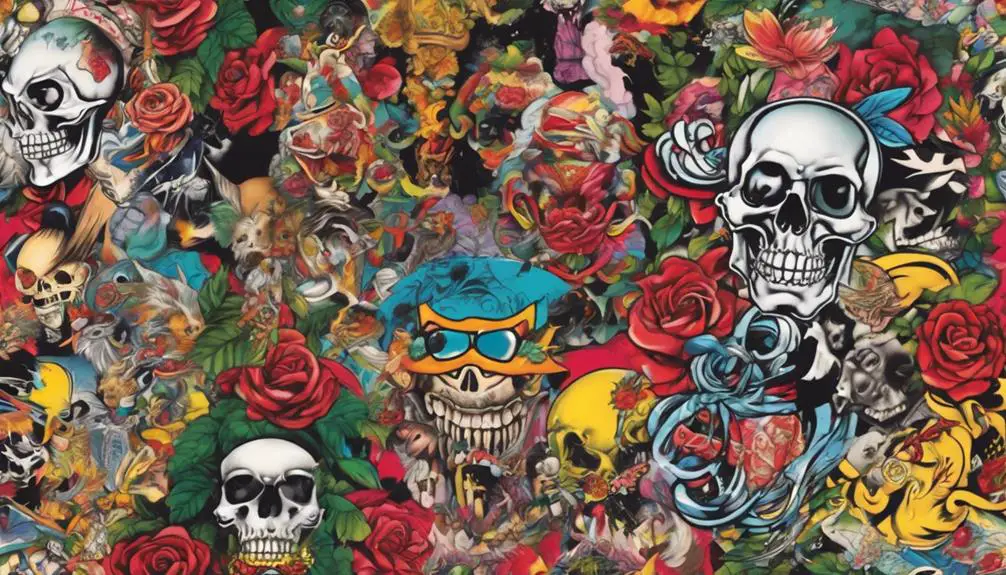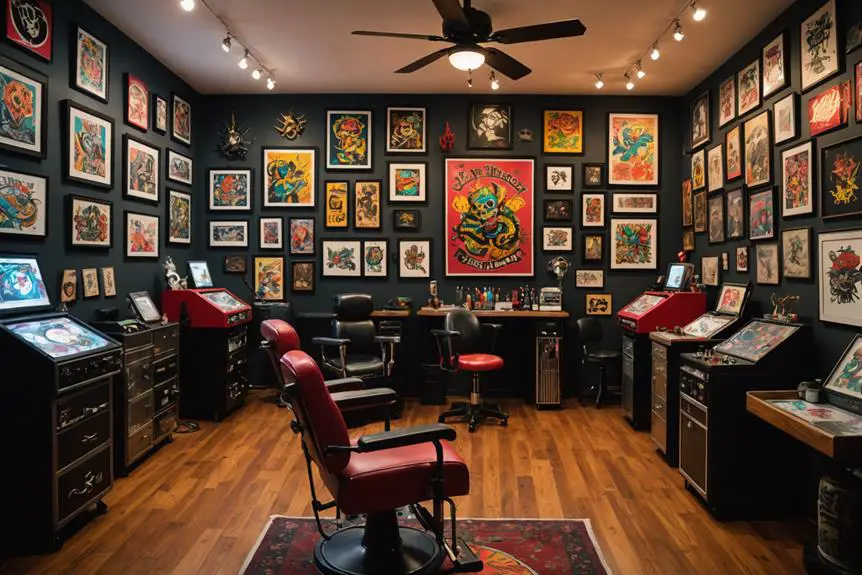In 2004, Ed Hardy was founded by tattoo artist Don Ed Hardy and fashion designer Christian Audigier, combining tattoo artistry with high fashion. Hardy's background in fine arts, along with his passion for tattoos, influenced their collaboration. They drew from traditional American and Japanese tattoo themes, creating striking designs that quickly became popular. The brand skyrocketed to fame, achieving over $700 million in sales by 2009. While it captivated youth culture, it also faced challenges like oversaturation. The story of Ed Hardy is fascinating, and there's much more to explore about its impact on fashion and art.
Background of Don Ed Hardy

Don Ed Hardy, born on January 5, 1945, in Des Moines, Iowa, discovered his passion for tattoos early in life, inspired by a friend's father who was a tattoo artist. This early exposure ignited a spark in him that would grow into a remarkable career.
After graduating with a Bachelor of Fine Arts in printmaking from the San Francisco Art Institute in 1967, Hardy was well-equipped to blend his artistic talent with his love for tattoos.
In 1977, he opened Tattoo City in San Francisco, where he transformed the perception of tattooing from a mere pastime to a respected art form. By studying under renowned tattoo artists and immersing himself in Japan's rich tattoo culture, Hardy embraced traditional tattoo aesthetics, which became a hallmark of his work. His unique style captivated many and set him apart in the tattoo community.
As his reputation flourished, Hardy began to explore collaborations that would later lay the groundwork for the Ed Hardy brand. Established in 2004, this clothing line integrated his tattoo art into the fashion industry, making it accessible to a broader audience.
The Ed Hardy brand became synonymous with bold designs and vibrant imagery, showcasing how tattoo art could transcend its origins and thrive in a new medium. With each step, Don Ed Hardy not only pushed the boundaries of tattooing but also redefined how society viewed this once-stigmatized art form.
Early Development of the Brand
Launching the Ed Hardy brand in 2004 marked a significant turning point in the fashion world, as Christian Audigier skillfully integrated Don Ed Hardy's tattoo art into a vibrant clothing line. You mightn't realize it, but Ed Hardy's designs drew heavily from traditional American tattoo art and Japanese culture, showcasing signature imagery like tigers and koi fish. This unique fusion set the brand apart and attracted attention. Ed Hardy's artistic epiphany, influenced by Japanese tattoo culture, played a vital role in shaping the brand's distinctive style, blending fine art with tattoo artistry artistic influences.
From the very beginning, Ed Hardy experienced rapid growth. By 2009, the brand peaked with over $700 million in sales and 70 retail stores worldwide. This success can largely be attributed to Audigier's aggressive marketing strategies, which included celebrity endorsements. You may remember seeing famous stars rocking Ed Hardy gear, which only fueled the brand's rise in pop culture.
As demand skyrocketed, extensive licensing deals followed, making Ed Hardy a household name. However, while the brand was basking in its early success, it also faced some criticism. Many people began to worry about the oversaturation of the market and the commercialization of what started as an artistic venture.
Despite this, the early development of Ed Hardy laid a strong foundation for its future. The clever blend of tattoo art with fashion not only captured the imagination of consumers but also created a lasting impact on the landscape of contemporary style.
Rise to Popularity

The rise to popularity of Ed Hardy can be traced back to its unique blend of tattoo artistry and fashion, which captivated a generation. Founded by Christian Audigier in 2004, Ed Hardy transformed the intricate tattoo art of Don Ed Hardy into a vibrant fashion brand. This fusion created a buzz, especially with its bold graphics featuring tigers, koi fish, and other striking designs that resonated with youth culture.
By 2009, Ed Hardy peaked in popularity, racking up over $700 million in sales and operating 70 stores worldwide. This success was largely driven by celebrity endorsements. Icons like Madonna and Jessica Alba were spotted wearing Ed Hardy, greatly boosting the brand's visibility and desirability. For many, wearing Ed Hardy wasn't just about fashion; it was a statement of identity, a way to embrace the edgy tattoo culture without the pain of needles.
However, this meteoric rise had its drawbacks. As the brand grew, it also faced challenges. After 2009, Ed Hardy experienced a decline in popularity, attributed to overexposure and a shift in perception. Many began to associate the brand with 'bad taste' and excessive commercialization, which tarnished its once-coveted image.
Despite the decline, Ed Hardy remains a notable part of fashion history, illustrating how a unique concept can capture the zeitgeist and eventually face the challenges of staying relevant in an ever-evolving market.
Licensing and Market Strategy
Following its rise to prominence, Ed Hardy's licensing and market strategy played a pivotal role in shaping its trajectory. Founded in 2004 through a licensing deal between artist Don Ed Hardy and designer Christian Audigier, the brand quickly became synonymous with tattoo art.
Audigier employed an aggressive marketing strategy that greatly boosted sales, peaking at over $700 million by 2009. This growth was fueled by collaborations with celebrities, making Ed Hardy a staple in youth and celebrity culture.
However, as the brand expanded, the extensive licensing and commercialization led to negative associations. Many began to view Ed Hardy as excessive and in "bad taste," which began to tarnish its brand reputation.
Legal disputes emerged between Hardy and Audigier, primarily over profits and image alterations. This conflict highlighted the challenges of maintaining artistic integrity within a commercial framework.
In 2011, Hardy regained control of the brand's master license, marking a turning point in its story. This shift offered an opportunity to reassess the brand's direction and distance it from the negative connotations that had developed.
While Ed Hardy initially thrived on its bold aesthetic and celebrity endorsements, the journey underscores the delicate balance between creativity and commercialism. As the brand continues to navigate its identity in the market, it reflects the complexities of modern branding and the impact licensing can have on artistic vision.
Legacy and Cultural Impact

Amidst its rise and fall, Ed Hardy's legacy and cultural impact remain significant in the fashion and tattoo industries. Founded by Christian Audigier in 2004, Ed Hardy quickly became a cultural phenomenon, reaching its peak in 2009 with over $700 million in sales. The brand's unique designs, inspired by Japanese tattoo art and traditional Americana, set it apart and drew attention from all corners of pop culture.
Celebrity endorsements played a huge role in Ed Hardy's rise, with stars like Madonna and Lindsay Lohan proudly sporting its bold styles. This visibility not only cemented the brand's place in the fashion world but also helped it become an emblem of a particular lifestyle.
However, the story isn't all glitter and glam. The brand's rapid success led to over-commercialization, diminishing its artistic integrity. As it flooded the market, the once-coveted designs lost their allure, serving as a cautionary tale in brand management.
Despite these challenges, Ed Hardy's legacy continues to influence contemporary fashion and tattoo culture. Discussions around its artistic value and potential for revival are still alive today.
The brand's journey highlights the delicate balance between commercial success and maintaining a genuine artistic vision. You can see remnants of Ed Hardy's impact in various fashion trends and tattoo styles, proving that its cultural footprint is far from erased.





some genuinely superb articles on this internet site, regards for contribution.